Puck (magazine)
Puck is a defunct magazine, the first successful humor magazine in the United States of colorful cartoons, caricatures and political satire of the issues of the day. It was founded in 1871 as a German-language publication by Joseph Keppler, an Austrian-born cartoonist.[1] It was published from 1871 until 1918.[2] Puck's first English-language edition was published in 1877, covering issues like New York City's Tammany Hall, presidential politics, and social issues of late 19th century to early 20th centuries. A collection of Puck cartoons dating from 1879 to 1903 is maintained by the Special Collections Research Center within the Gelman Library of The George Washington University.[3] The Library of Congress also has an extensive collection of Puck Magazine prints online. The Florida Atlantic University Libraries Special Collections Department also maintains a collection of both English and German edition Puck cartoons dating from 1878 to 1916.[4][5]
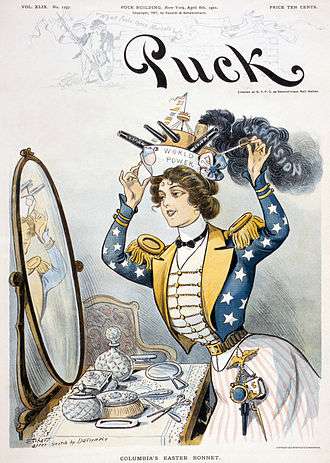
History
The weekly magazine was founded by Joseph Keppler in St. Louis. It began publishing German language periodicals in March 1871, though initially the German-language periodical publication failed.[6] After working with Leslie's Illustrated Weekly in New York—a well-established magazine at the time—Keppler created a satirical magazine called Puck, originally published in German. In 1877, after gaining wide support for an English version of Puck, Keppler published its first issue in English. The first English edition was 16 pages long and was sold for 16 cents.[7] Puck gained notoriety for its witty, humorous cartoons and was the first to publish weekly cartoons using chromolithography in place of wood engraving, offering three cartoons instead of one.[8] In its early years of publication, Puck's cartoons were largely printed in black and white, though later editions featured colorful, eye-catching lithographic prints in vivid color.
The English language magazine continued in operation for more than 40 years under several owners and editors, until it was bought by the William Randolph Hearst company in 1916 (ironically, one 1906 cartoon mocked Hearst's bid for Congress with his newspapers' cartoon characters). The publication lasted two more years; the final edition was distributed September 5, 1918. A typical 32-page issue contained a full-color political cartoon on the front cover and a color non-political cartoon or comic strip on the back cover. There was always a double-page color centerfold, usually on a political topic. There were numerous black-and-white cartoons used to illustrate humorous anecdotes. A page of editorials commented on the issues of the day, and the last few pages were devoted to advertisements.
"Puckish" means "childishly mischievous". This led Shakespeare's Puck character (from A Midsummer Night's Dream) to be recast as a charming near-naked boy and used as the title of the magazine. Puck was the first magazine to carry illustrated advertising and the first to successfully adopt full-color lithography printing for a weekly publication. The magazine consisted of 16 pages measuring 10 inches by 13.5 inches with front and back covers in color and a color double-page centerfold. The cover always quoted Puck saying, "What fools these mortals be!" The jaunty symbol of Puck is conceived as a putto in a top hat who admires himself in a hand-mirror. He appears not only on the magazine covers but over the entrance to the Puck Building in New York's Nolita neighborhood, where the magazine was published, as well.
In May 1893, Puck Press published A Selection of Cartoons from Puck by Joseph Keppler (1877–1892) featuring 56 cartoons chosen by Keppler as his best work. Also during 1893, Keppler temporarily moved to Chicago and published a smaller-format, 12-page version of Puck from the Chicago World's Fair grounds. Shortly thereafter, Joseph Keppler died, and Henry Cuyler Bunner, editor of Puck since 1877 continued the magazine until his own death in 1896. Harry Leon Wilson replaced Bunner and remained editor until he resigned in 1902.[9] Joseph Keppler Jr. then became the editor.
Years after its conclusion, the "Puck" name and slogan were revived as part of the Comic Weekly Sunday comic section that ran on Hearst's newspaper chain beginning in September 1931 and continuing until the 1970s. It was then revived again by Hearst's Los Angeles Herald Examiner, which folded in 1989.
Distinguished contributors
Over the years, Puck employed many early cartoonists of note, including, Louis Dalrymple, Bernhard Gillam, Friedrich Graetz, Livingston Hopkins, Frederick Burr Opper, Louis Glackens, Albert Levering, Frank Nankivell, J. S. Pughe, Rose O'Neill, Charles Taylor, James Albert Wales, and Eugene Zimmerman.
Politics and religion

An 1890 Puck cartoon depicts President Benjamin Harrison at his desk wearing his grandfather's hat which is too big for his head, suggesting that he is not fit for the presidency. Atop a bust of William Henry Harrison, a raven with the head of Secretary of State James G. Blaine gawks down at the President, a reference to the famous Edgar Allan Poe poem "The Raven". Blaine and Harrison were both at odds over the recently proposed McKinley Tariff.
As Thomas (2004) explains:
[I]n an age of partisan politics and partisan journalism, Puck became the nation's premier journal of graphic humor and political satire, played an important role as a non-partisan crusader for good government and the triumph of American constitutional ideals. Its prime targets, however, were not just corrupt machine politicians. The magazine included as well what it, like the letterpress, condemned as the nefarious political agenda of the Catholic Church, especially its new Pope, Leo XIII. Indeed, New York's infamous Irish Tammany Hall, committed to spoils and patronage as the means of dominating the body politic, was all the more dangerous to Puck because, beginning in the 1870s, Irish Catholics dominated it. The hall's Irish Catholic base enabled the magazine to rationalize more completely its conviction that the Catholic Church, ruled by a foreign potentate dressed in the irrational garb of infallibility, was a menace not only to the nation's body politic but also to its democratic soul. If allowed to proceed unimpeded, the pope and his minions, along with Tammany's bosses and supporters, would convert the nation into their personal fiefdom. Puck was not about to let that happen. In cartoons and editorials spanning two decades, the magazine blasted and often conjoined both Tammany and the papacy with invidious comparisons that left few readers in doubt as to their sympathies.
Puck Building
Puck was housed from 1887 in the landmark Chicago-style, Romanesque Revival Puck Building at Lafayette and Houston streets, New York City. The steel-frame building was designed by architects Albert and Herman Wagner in 1885, as the world's largest lithographic pressworks under a single roof, with its own electricity-generating dynamo. It takes up a full block on Houston Street, bounded by Lafayette and Mulberry streets.
Mad (once located two blocks away at 225 Lafayette Street) parodied Puck's motto as "What food these morsels be!"
London edition
A London edition of Puck was published between January 1889 and June 1890. Amongst contributors was the English cartoonist and political satirist Tom Merry.[10]
Puck cartoons
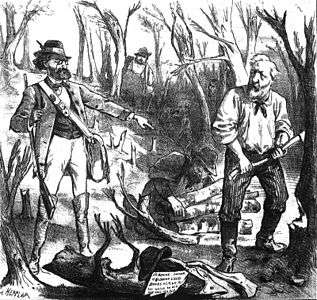 c. 1878: Secretary of the Interior Carl Schurz accosts U.S. Representative James G. Blaine chopping a tree in the forest
c. 1878: Secretary of the Interior Carl Schurz accosts U.S. Representative James G. Blaine chopping a tree in the forest European Royalties: Go West! (after assassination of Alexander II of Russia) March 30, 1881
European Royalties: Go West! (after assassination of Alexander II of Russia) March 30, 1881 Emoticons, March 30, 1881
Emoticons, March 30, 1881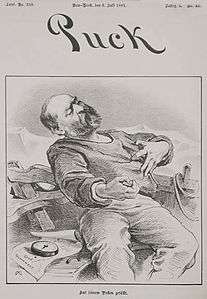 July 6, 1881: President James A. Garfield, auf seinem Posten gefällt
July 6, 1881: President James A. Garfield, auf seinem Posten gefällt "Gone to meet John Kelly", figure identified as "Boss McLaughlin" (Hugh McLaughlin, a political boss), November 9, 1881 cover
"Gone to meet John Kelly", figure identified as "Boss McLaughlin" (Hugh McLaughlin, a political boss), November 9, 1881 cover German edition: Monopoly Millionaires Dividing the Country (William Henry Vanderbilt, Jay Gould, Cyrus West Field, Russell Sage; Andrew Carnegie) 1885
German edition: Monopoly Millionaires Dividing the Country (William Henry Vanderbilt, Jay Gould, Cyrus West Field, Russell Sage; Andrew Carnegie) 1885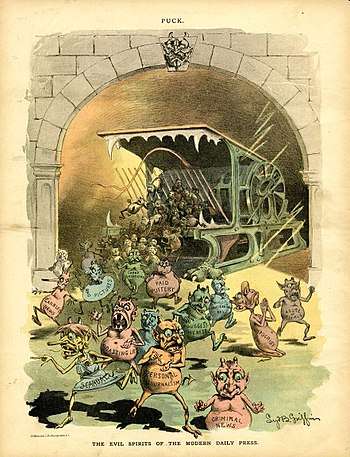 Nasty little printer's devils, 1888
Nasty little printer's devils, 1888- Cyclone as metaphor for political revolution (election of 1894)
.jpg) School Begins, January 25, 1899
School Begins, January 25, 1899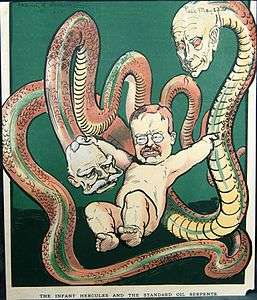 "The Infant Hercules and the Standard Oil serpents", May 23, 1906 issue; depicting U.S. President Theodore Roosevelt "grabbing the head of Nelson W. Aldrich and the snake-like body of John D. Rockefeller" by Frank A. Nankivell
"The Infant Hercules and the Standard Oil serpents", May 23, 1906 issue; depicting U.S. President Theodore Roosevelt "grabbing the head of Nelson W. Aldrich and the snake-like body of John D. Rockefeller" by Frank A. Nankivell "Paris in half-mourning" by Ralph Barton, 1915.
"Paris in half-mourning" by Ralph Barton, 1915.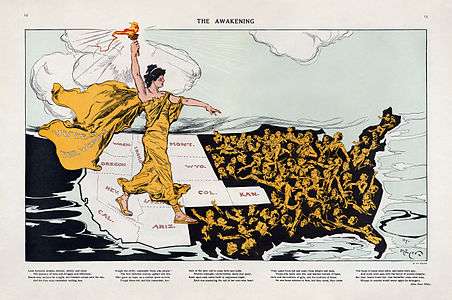 The Awakening by Henry "Hy" Mayer, 1915.
The Awakening by Henry "Hy" Mayer, 1915. Rapid Transit to Sheol - Where We Are All Going According to the Reverend Dr. Morgan Dix, by Joseph Ferdinand Keppler, 1888.
Rapid Transit to Sheol - Where We Are All Going According to the Reverend Dr. Morgan Dix, by Joseph Ferdinand Keppler, 1888.
See also
Notes
- "U.S. Senate: Puck". www.senate.gov. Retrieved November 27, 2018.
- Jeremy Glass (November 24, 2014). "5 Defunct Magazines that Changed America". Thrillist. Retrieved May 1, 2016.
- Guide to the Samuel Halperin Puck and Judge Cartoon Collection, 1879–1903, Special Collections Research Center, Estelle and Melvin Gelman Library, The George Washington University
- "Catalog Record for Puck Magazine". FAU Libraries Catalog. 2018. Retrieved 2018. Check date values in:
|access-date=(help) - "Catalog Record for Puck Magazines, German". FAU Libraries Catalog. 2018. Retrieved 2018. Check date values in:
|access-date=(help) - "TR Center - Puck Magazine". www.theodorerooseveltcenter.org. Retrieved November 27, 2018.
- "TR Center - Puck Magazine". www.theodorerooseveltcenter.org. Retrieved November 27, 2018.
- "U.S. Senate: Puck". www.senate.gov. Retrieved November 27, 2018.
- "Guide to the Harry Leon Wilson Papers, ca. 1879–1939". Berkeley, CA: Bancroft Library. Retrieved April 8, 2010.
- Simon Houfe (1978). Dictionary of British Book Illustrators and Caricaturists 1800–1914.
References
- West, Richard Samuel (1988). Satire On Stone. University of Illinois Press. ISBN 0-252-01497-9.
- Thomas, Samuel J. (Summer 2004). "Mugwump Cartoonists, the Papacy, and Tammany Hall in America's Gilded Age". Religion and American Culture. 14 (2): 213–250. doi:10.1525/rac.2004.14.2.213.
- Kahn, Michael Alexander; West, Richard Samuel (2004). What Fools These Mortals Be!: The Story of Puck; America's First And Most Influential Magazine of Color Political Cartoon. San Diego, CA: IDW Publishing. ISBN 978-1-63140-046-9.
External links
| Wikimedia Commons has media related to Puck (magazine). |
- Puck at HathiTrust
- Gallery of 1877 Puck Magazine caricatures by Joseph Keppler
- Cartoons from Puck featuring U.S. President Theodore Roosevelt
- Guide to the Samuel Halperin Puck and Judge Cartoon Collection, 1879–1903, Special Collections Research Center, Estelle and Melvin Gelman Library, The George Washington University